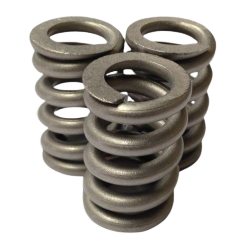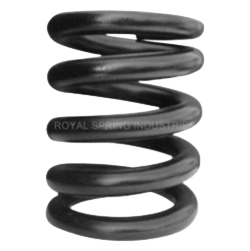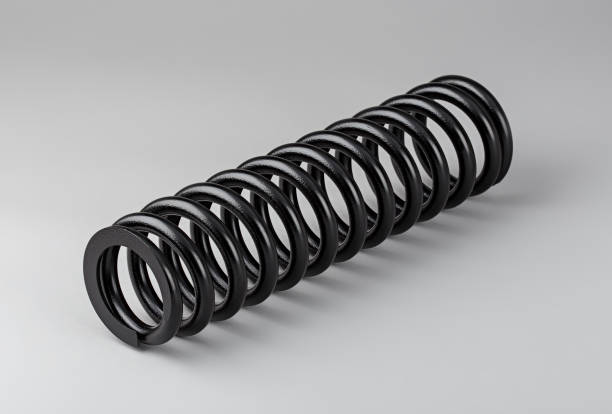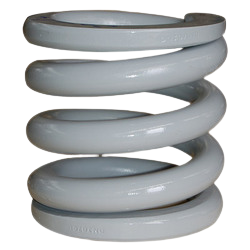Compression Spring Manufacturers




What is a Compression Spring :
A Compression Spring is a type of mechanical Spring designed to resist compressive forces. It’s typically made of coiled wire and works by compressing when a load is applied, storing energy in the process and when the load is removed, the Spring returns to its original shape (free length). Compression Springs are used in a wide range of applications, from automotive components to household items due to their ability to provide force and absorb shock.
Compression Spring design :
Compression Springs can be designed with various end types and shapes, each affecting their performance and application. Here’s a brief overview of the different designs :
● Open ends : The ends of this deign of Compression Springs are not closed or ground flat. Open ends Compression Spring can be used where end alignment and consistent load distribution are less critical. Open ends are often simpler and less expensive to manufacture but might not be as stable in certain applications.
● Closed ends : The ends of this design of Compression Springs are closed by forming the wire into a rounded or flattened shape. Closed ends Compression Spring can help improve load distribution and reduce the risk of the coil ends becoming misaligned. This design is often used in applications where the Spring needs to be more stable and aligned.
● Pigtail ends : The ends of this design of Compression Springs are coiled in a pigtail shape, usually with a small curl or hook. Pigtail ends Compression Springs are often used in applications where the Spring needs to be attached or connected to another component. This design helps in easier attachment and alignment.
● Conical ends : The ends of this design of Compression Springs are tapered, creating a conical shape. Conical ends Compression Springs are designed to guide the Spring into a more controlled alignment when compressed. They can help reduce friction and improve the performance of the Spring, especially in applications where space is constrained or precise alignment is necessary.
Compression Spring specification :
Compression Spring is manufactured from round bar or rectangular bar of Spring steels. It is prepared by winding in coiling machine maintaining the bore or inner dia. as per requirement up to required free height. Each single wind is called “Coil”. Total numbers of coil may be extended up to non functioning free height. Compression Springs are manufactured in the form of gap between each coils is called Helical Compression Spring and also other type in solid for without gap and forming pulling hook at both end called Extension Spring. Compression Coil Spring functions for absorbing load, jerk, shock, vibration etc. Compression Spring is designed based on working area and required load will apply on it. Compression Spring type both ends are ground finished for proper fitment at working spot. The load measurement is based on the wire dia, inner / outer dia, total coils and free length. Compression Spring functions by applying pressure to gain actual performance while free height is reduced and tension type Coil Spring by installing one end hook fixed with device and pulling or hanging other end hook. At the time of function it extends the length up to capacity limit and absorbed load. When load or tension is released, the Spring return back to previous position. Proper heat treatment is mandatory of this Spring for fatigue life and perfect performance.
Compression Spring types :
● Helical Coil Compression Springs : This type of Compression Springs are coiled in a helical shape and are designed to resist compressive forces. When a load is applied, the coils compress and store energy. It is used in various applications, such as in automotive suspensions, electronic devices, and machinery, where the Spring needs to absorb shock or provide a restoring force.
● Tension Springs : This type of Compression Springs are also known as Extension Springs, these are designed to resist stretching forces. They are wound in a helical shape but work by elongating rather than compressing. They are commonly used in applications like door closures, trampolines, and other mechanisms where pulling forces are involved.
● Torsion Springs : This type of Compression Springs are designed to resist rotational forces or twisting. They are typically wound in a spiral shape and work by turning around their axis. It is often used in applications where rotational force is required, such as in clothespins, garage doors, and various types of machinery.
Compression Spring application :
● Automotive suspension : Compression Springs are used in automotive suspension system to absorb shocks and vibrations from the road, providing a smoother ride and improving vehicle handling. They help to maintain consistent contact between the tires and the road, reducing wear and tear on other suspension components.
● Railway bogie & wagon : Compression Springs are used in Railway bogies and wagons, used to support the load and absorb the impact from uneven tracks, ensuring a smoother ride and reducing wear on the Rail infrastructure. They help to maintain stability and comfort for passengers and cargo while also improving the durability of Rail vehicles.
● Machinery :
# Crushers : Compression Springs are used to apply force or hold components together, such as in the adjustment of the crusher’s gap or for Spring-loaded safety mechanisms.
# Vibrators : Compression Springs can be used to create the necessary vibration or to absorb and control the vibration in the machinery.
# Screening machines : Compression Spring in screening equipment can help to adjust the tension of the screen mesh or absorb vibrations.
# Valves : Compression Spring in Valves can help in controlling the flow of fluids by maintaining the Valve in the correct position.
# Actuators : Compression Springs are used in actuators to provide the force needed for movement or control.
# Isolators : Compression Spring helps to absorb and isolate vibrations and shocks in Isolator machine, improving performance and reducing noise.
# Elevators : Compression Springs in Elevators can be used in counterweight systems or to absorb impacts during movement.
Compression Spring manufacturing process :
Step A : Rawmaterial Dimension Checking
Step B : Rawmaterial Chemical Testing
Step C : Centre Less Grinding
Step D : Both End Forging
Step E : Bar Heating in Furnace at approx. 950º C
Step F : Coiling on Coiling Pitching Machine
Step G : Oil Quenching for Hardening
Step H : Tempering in Furnace at approx. 450º C
Step I : Scragging Test
Step J : Height Checking
Step K : End Grinding
Step L : Dimension Checking
Step M : Load Testing
Step N : Shot Peening
Step O : Surface Oiling / Painting / Coating
Step P : Packing
Step Q : Delivery
Why are we the top Compression Spring maker ?
● 40 years experience : With four decades of expertise in the industry, we have honed our skills and knowledge to deliver superior Compression Springs. Our extensive experience ensures that we understand the nuances of quality and performance like no other.
● Advanced quality control system : We utilize state-of-the-art control systems to monitor and maintain the highest standards of production. Our technology ensures precision and consistency in every Spring we manufacture. We are also ISO 9001:2015 certified.
● Competitive pricing : We offer the most competitive prices in the market without compromising on quality. Our efficient manufacturing processes and cost-effective solutions enable us to provide the best value for your investment.
● Global customer satisfaction : Our commitment to quality and service has earned us the trust of buyers worldwide. We take pride in our strong reputation for reliability and excellence in the global market.
● Guaranteed performance : We stand behind our products with a guarantee of performance. Our rigorous testing and quality assurance processes ensure that every Spring meets the highest standards of durability and functionality.
Compression Spring manufacturers :
We are Compression Spring manufacturers up to the following capacity :
Wire Dia. – upto 70 mm.
Outer Dia. – upto 500 mm.
Free Height – upto 1000 mm.
Total Coils – As per user’s requirement.
Load Capacity – upto 40 Tons. (per pc.)
● Raw-material grades used : Spring Steels as per Indian standard – BS:970 EN-42, BS:970 EN-45, BS:970 EN-47, 50Cr.V4, 50Cr.4V2, 51Cr.V4, 50Cr.MoV4, 50Si7, 55Si7, 60Si7, SUP-9, SUP-9A, SAE-5160, IS:4454 Part-1 Grade-2, IS:4454 Part-1 Grade-2D, Stainless Steel etc. and others similar foreign grades JIS, ASTM etc.
● Painting and Coating used : Synthe2tic Enamel Paint, Powder Coating, Phosphate, Zinc Coating etc.
Compression Spring price :
As this is a custom product, price of Compression Spring is depends on it’s dimension, raw-material grade, design type, weight and surface treatment like shot-peening, painting etc.
